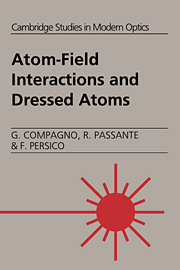Book contents
- Frontmatter
- Contents
- Preface
- 1 The classical electromagnetic field in the absence of sources
- 2 The quantum electromagnetic field in the absence of sources
- 3 The quantum matter field
- 4 Electrodynamics in the presence of sources
- 5 Atoms dressed by a real e.m. field
- 6 Dressing by zero-point fluctuations
- 7 Energy density around dressed atoms
- 8 Further considerations on the nature of dressed states
- Appendix A Multipolar expansion for the vector potential
- Appendix B Electric polarization and magnetization of the Schrödinger field
- Appendix C Rayleigh-Schrödinger perturbation theory
- Appendix D Sum rules for the nonrelativistic hydrogen atom
- Appendix E From Gauss system to SI
- Appendix F Gauge invariance and field interactions
- Appendix G Dressed sources in relativistic QED and in QCD
- Appendix H The energy-momentum tensor and Lagrangian density
- Appendix I The dressed relativistic hydrogen atom
- Appendix J The nonrelativistic Lamb shift in a hydrogenic atom
- Index
3 - The quantum matter field
Published online by Cambridge University Press: 12 November 2009
- Frontmatter
- Contents
- Preface
- 1 The classical electromagnetic field in the absence of sources
- 2 The quantum electromagnetic field in the absence of sources
- 3 The quantum matter field
- 4 Electrodynamics in the presence of sources
- 5 Atoms dressed by a real e.m. field
- 6 Dressing by zero-point fluctuations
- 7 Energy density around dressed atoms
- 8 Further considerations on the nature of dressed states
- Appendix A Multipolar expansion for the vector potential
- Appendix B Electric polarization and magnetization of the Schrödinger field
- Appendix C Rayleigh-Schrödinger perturbation theory
- Appendix D Sum rules for the nonrelativistic hydrogen atom
- Appendix E From Gauss system to SI
- Appendix F Gauge invariance and field interactions
- Appendix G Dressed sources in relativistic QED and in QCD
- Appendix H The energy-momentum tensor and Lagrangian density
- Appendix I The dressed relativistic hydrogen atom
- Appendix J The nonrelativistic Lamb shift in a hydrogenic atom
- Index
Summary
Introduction. In the previous two chapters we have discussed electrodynamics in the absence of charges and currents. We are now ready to investigate the nature of these charges and currents. Thus in this chapter we introduce the concept of matter field, both classical and quantized, which as we will see acts as a source of the electromagnetic field. The difficulties encountered in the definition of convenient wave equations (Klein-Gordon and Dirac) for a relativistic particle are examined in Section 3.1, and they lead naturally to consider these equations as equations of motion of a field, obtainable from an appropriate field Lagrangian. Thus the probabilistic single-particle interpretation of the wave equations is abandoned, and Section 3.2 is dedicated to the Klein-Gordon field, which is introduced by an appropriate Klein-Gordon Lagrangian, yielding the Klein-Gordon equation. The Klein-Gordon field is then second-quantized, both in its real and complex versions. The eigenstates of the Hamiltonian of this second-quantized field are shown to correspond to many-particle states satisfying Bose-Einstein statistics. An analogous procedure is followed in Section 3.3 for the Dirac equation, leading to the definition of a Dirac field which upon second quantization yields a field Hamiltonian whose eigenstates correspond to many-particle states satisfying Fermi-Dirac statistics. For both fields the energy-momentum tensors are defined and various conservation properties are obtained.
- Type
- Chapter
- Information
- Atom-Field Interactions and Dressed Atoms , pp. 52 - 80Publisher: Cambridge University PressPrint publication year: 1995

